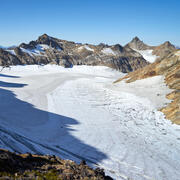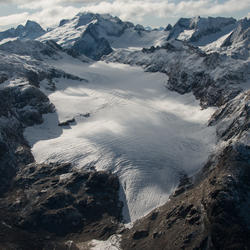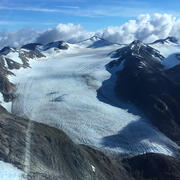The USGS Benchmark Glacier Project measures changes in mass balance at five benchmark glaciers: Gulkana (AK), Wolverine (AK), Lemon Creek (AK), South Cascade (WA), and Sperry (MT).
Return to Glaciers and Climate Project
Benchmark Glaciers
The USGS Benchmark Glacier Project measures changes in mass balance at five benchmark glaciers: Gulkana (AK), Wolverine (AK), Lemon Creek (AK), South Cascade (WA), and Sperry (MT). The graphics below depict the mass balance over the period of record for each glacier. The Alaskan and Washington datasets constitute the longest continuous set of mass balance data in North America (O’Neel and others, 2019). With the inclusion of Sperry Glacier in 2013, these five research sites were unified into a single project with common field and analysis methodologies to enable comparison among the glaciers. This project aims to advance the quantitative understanding of glacier-climate interactions from local to regional scales. The current focus is on merging the long-term field records with newer, richer remote sensing data.
Source: O'Neel, S., McNeil, C., Sass, L., Florentine, C., Baker, E., Peitzsch, E., McGrath, D., Fountain, A., and Fagre, D. (2019). Reanalysis of the US Geological Survey Benchmark Glaciers: Long-term insight into climate forcing of glacier mass balance. Journal of Glaciology, 65(253), 850-866. doi:10.1017/jog.2019.66


Glaciers and Landscape Change
South Cascade Glacier
Lemon Creek Glacier
Gulkana Glacier
Additional Research Glaciers
Wolverine Glacier
Sperry Glacier
Mass Balance Methods - Measuring Glacier Change
The USGS Benchmark Glacier Project measures changes in mass balance at five benchmark glaciers: Gulkana (AK), Wolverine (AK), Lemon Creek (AK), South Cascade (WA), and Sperry (MT).
Return to Glaciers and Climate Project
Benchmark Glaciers
The USGS Benchmark Glacier Project measures changes in mass balance at five benchmark glaciers: Gulkana (AK), Wolverine (AK), Lemon Creek (AK), South Cascade (WA), and Sperry (MT). The graphics below depict the mass balance over the period of record for each glacier. The Alaskan and Washington datasets constitute the longest continuous set of mass balance data in North America (O’Neel and others, 2019). With the inclusion of Sperry Glacier in 2013, these five research sites were unified into a single project with common field and analysis methodologies to enable comparison among the glaciers. This project aims to advance the quantitative understanding of glacier-climate interactions from local to regional scales. The current focus is on merging the long-term field records with newer, richer remote sensing data.
Source: O'Neel, S., McNeil, C., Sass, L., Florentine, C., Baker, E., Peitzsch, E., McGrath, D., Fountain, A., and Fagre, D. (2019). Reanalysis of the US Geological Survey Benchmark Glaciers: Long-term insight into climate forcing of glacier mass balance. Journal of Glaciology, 65(253), 850-866. doi:10.1017/jog.2019.66











